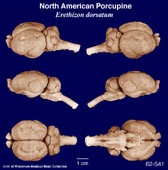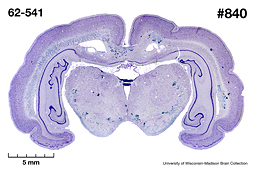|
North
American Porcupine Erethizon dorsatum
Head and body lengths of E. dorsatum range from 645-680
mm and tail lengths are 145-300 mm. Weights are 3.5-7.0 kg,
but large males can weigh as much as 18 kg. The pelage is usually
dark brown or black, woolly and dense with the upperparts of
the body covered with more than 30,000 quills which are yellowish
at the base and have a dark tip. These quills are about 2 mm
in diameter and 75 mm long with a barbed end. The underparts
of the North
American porcupine lack the quills, but
are covered with stiff, dark hairs.
E. dorsatum is primarily terrestrial, but the arboreal
and the naked feet have strong curved claws which enable it
to move easily throughout the trees to get food. There are four
toes on the forefoot and five on the hindfoot. The skull is
very large in proportion to the body and the eyes are set far
apart. Females have two sets of mammae, one pectoral pair and
one abdominal pair.
The preferred habitat of E. dorsatum is mixed hardwood
and softwood forest, though it is highly adaptable and may be
found in open tundra, rangeland and desert. Vegetated riparian
areas are preferred, however, when the animal is away from forested
areas. E. dorsatum is also a capable swimmer, the quills
providing a great amount of buoyancy. Several dens are used
in a variety of settings: hollow logs and trees, caves, crevices,
burrows, snowbanks, or nests in trees. The North American porcupine
has poor vision, but highly developed senses of smell and hearing.
It is primarily nocturnal, but will forage during the day as
well. E. dorsatum does not hibernate. It will remain
in its burrow for long periods of time when the weather is bad,
though. Foraging distances from the den site vary from and average
of 8 meters in the winter and 150 meters in the summer, using
distinctive runways from the den to the food source.
During
the winter, the diet consists primarily of pine needles, and
the cambium and inner bark layers of trees. In spring and summer,
E. dorsatum is treated to buds, tender twigs, roots,
stems, leaves, flowers, seeds, berries, nuts and other vegetation.
North
American porcupines are generally solitary, though two individuals
may share a feeding tree and several individuals may share a
den on a rotating basis. Only during the winter may several
individuals be found together in one den. In the fall, a number
of animals may gather at a nocturnal feeding site and vocalize.
Vocalizations are varied, including grunts, moans, coughs, whines
and tooth chatters.
The North
American porcupine is not an aggressive
animal and when threatened will flee or climb a tree to escape
harm. If cornered, the North
American porcupine erects its quills, which
are not shot from the animals body, but will work their way
into the skin of an unfortunate victim at the rate of 1 mm per
hour. If the quill reaches a vital organ, it can cause death.
Among animals that prey on E. dorsatum, a few are very
adept at avoiding the quills: bobcats, wolverines and fishers
flip the porcupine on its back exposing its vulnerable underside.
Great horned owls and other carnivorous mammals also prey on
E. dorsatum.
Mating season occurs in fall and early winter with the male
and female both engaging in a dance, after which the male sprays
the female with urine. Once mating is done, the female repels
the male. She is polyestrous and if fertilization has not occurred,
she will be receptive again in 25-30 days. Gestation is 207-215
days resulting in one, or sometimes two, offspring. The newborns
have open eyes, are covered with long, black hair and short
soft quills. They weigh 340-360 grams and can walk somewhat
unsteadily, but can climb trees within days and instinctively
turns its rump toward danger. Weaning is thought to occur fairly
early in the wild as the babies can survive solely on vegetation
at about 2 weeks of age. Weight is gained rapidly - about 450
grams per day - and males reach sexual maturity at about 2.5
years. There are records of some individuals living as long
as 18 years in the wild.
E. dorsatum is found from C Alaska (USA) to S Hudson
Bay and Labrador (Canada), south to E Tennessee, C Iowa, and
C Texas (USA), N Coahuila, Chihuahua, and Sonora (Mexico), and
S California (USA).
|



